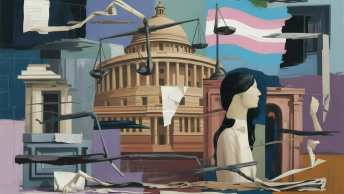This third, and final, post builds on posts of yesterday and the day before on the Naz Foundation Case. In today’s post, I discuss, among other things, the Delhi High Court’s use of “compelling state interest” as a standard for assessing fundamental rights infringements as well as its handling of the equality and equal protection issue.
1. Compelling State Interest and Morality.
Paragraph 75 of Naz Foundation appears under the caption “morality as a ground of a restriction to fundamental rights.” This paragraph discusses restrictions on the conjoined fundamental right to privacy-dignity as well as the fundamental right to health. The bench begins by stating that a law infringing a fundamental privacy right must satisfy a “compelling state interest.” It correctly attributes this standard to Justice Mathew’s Gobind opinion. It then travels beyond Gobind to hold that the enforcement of public morality is not a compelling state interest to “justify invasion of the zone of privacy of adult homosexuals engaged in consensual sex in private.” To paraphrase Justice Mathew’s own words in Keshavananda, “I have tried, like Jacob of the Old Testament, to wrestle all night with the angel,” namely, the use of the “compelling state interest” standard in Indian constitutional adjudication. I certainly have no quarrel with the general proposition that enforcement of morality is not a compelling state interest, much less an important or even a marginal interest. However, I believe that Naz Foundation’s use of the “compelling state interest” standard here is completely out of line with prevailing Indian precedents. It is true that Justice Mathew proposed and used the “compelling state interest” standard in Gobind to determine whether the regulations at issue in that case passed constitutional muster. I believe he was so greatly enamored with recent American decisions on contraception and abortion that he readily imported their teachings to India without adequate due diligence. It is one thing to refer to foreign precedents to expand the meaning of the fundamental rights, it is quite another to borrow standards for how those rights are to be restricted from jurisdictions with different analytical frameworks for constitutional questions.It should be pointed out that the “compelling state interest” standard, which Justice Mathew enthusiastically adopted in Gobind, is part of the U.S. Supreme Court’s strict-scrutiny test to screen restrictions on fundamental rights. That test was judicially developed largely because the American Constitution provides little textual guidance on what restrictions can be imposed on fundamental rights. In India, the situation is rather different because our Constitution has “in-house” rules with specific grounds on which “reasonable” restrictions can be imposed on most fundamental rights (see, e.g., Article 19 (2)).
In fairness to the Naz Foundation bench, I should point out that Justice Mathew was a fairly consistent advocate for varying the applicable standard of judicial review depending on the subject involved. For instance, in Ambica Mills, he argued that laws regulating economic activity should “be viewed differently” from laws which concern freedom of speech and religion, voting, procreation, or criminal procedure. He would defer to legislative wisdom on economic laws and exercise greater vigilance in other areas (of course, his deference to economic laws was in the context of India’s flirtation with socialism during the 1970s!).
Aside from Gobind, I am hard pressed to find any major decision that either affirms or applies the “compelling state interest” standard. Rather, as Naz Foundation, itself, says in paragraph 25, after Menaka, any interference with life or personal liberty “must be right and just and fair and not arbitrary, fanciful, or oppressive.” This “just, fair, and reasonable” standard has been the generally applicable benchmark to assess governmental action for the past three decades now. One way to reconcile the apparent contradiction between paragraphs 25 and 75 in Naz Foundation would be to apply both standards together. In others words, every governmental action that violates a fundamental right must henceforth satisfy Menaka’s test of “just, fair, and reasonable” as well as Gobind’s requirement of furthering a “compelling state interest.” If this interpretation of Naz Foundation is correct, I’m afraid it is a rather radical restatement of the law. Another way to resolve this conundrum would be to only apply the Gobind + Menaka formula to questions about penumbral or uncodified rights like privacy and health. Questions concerning codified rights would only have to meet the Menaka standard. But this solution would imply a higher constitutional bar for actions affecting penumbral rights than those actions affecting textual rights. This outcome would be irrational since penumbral rights are, in fact, derivatives of textual rights.
2. Substitution of Morality Standards.
Let me turn now to the impressive manner in which Naz Foundation redefined the morality argument and turned it on its head. Rebutting the notion that public disapproval of homosexual conduct is an accurate barometer of morality, Naz Foundation brilliantly argues that it is “constitutional morality” rather than popular morality that ought to be the applicable yardstick. This aspect of Naz Foundation is, perhaps, what I like most about the case and underscores why I believe it is a landmark decision. The idea of a controlling “constitutional morality” is in, some sense, a continuation of the bench’s insistence on a secular approach in the judicial process case without risking a footfall into religious or sectarian ditches.
At the same time, I do not believe that Naz Foundation’s substitution of constitutional morality for popular morality is a silver bullet. Just consider the spaghetti bowl of inconsistent Supreme Court decisions on whether there is a constitutional right to trade in liquor or if it is res extra commercium. Some of our most enlightened justices have tied themselves up in knots over this issue because of their concern about its underlying moral implications.
I should also point out that Naz Foundation does not imply that any morality-based legislation or governmental action is no longer permitted. Rather, it argues that mere public disapproval is an inadequate reason to restrict a fundamental right.
3. Implied Desuetude of Section 377.
I want to end my discussion of morality in Naz Foundation by focusing on a most intriguiging sentence in paragraph 86, which reads:
In fact, the admitted case of the Union of India that Section 377 IPC has generally been used in cases of sexual abuse or child abuse, and conversely that it has hardly ever been used in cases of consenting adults, shows that criminalization of adult same-sex conduct does not serve any public interest.
In this passage, the court was referring to the Additional Solicitor General’s argument that Section 377 should be saved because it was not being enforced against homosexuals. The high court initially rejected this contention in paragraph 74 as contrary to evidence and testimony proffered by the petitioners. Yet, interestingly, the bench returns to this argument in paragraph 86, but only to turn tables on the government. It reasons that, if Section 377 has not been used to prosecute adult same-sex conduct, one can legitimately question whether such conduct should at all be criminally proscribed. In other words, if a statutory provision has fallen into disuse, why bother maintaining it? Although Naz Foundation does not refer to it, there is, in fact, an old common-law doctrine called “desuetude” that supports this line of reasoning. This doctrine has, in fact, been recognized by the Indian Supreme Court in Municipal Corporation v. Bharat Forge, (1995) 3 S.C.C. 434, and it is a pity that it was not considered in this case. Perhaps, it was because petitioners were not confident that they could satisfy all the elements of the doctrine.
For desuetude to set in, the statute in question must have been in disuse for a substantial period of time and some form of contrary practice must have evolved during this period.
4. The Equality Detour.
As a threshold matter, I wonder why the bench even bothered addressing the equality argument. It had already resolved that Section 377 violated the penumbral fundamental right of equality-dignity, which was sufficient ammunition for its conclusion that Section 377 was unconstitutional. In fact, it is for this reason that the bench felt it was unnecessary to deal with the argument based on the fundamental freedoms in Article 19. Could not the same approach have been taken with respect to equality? In my view, the equality section is Naz Foundation’s Achilles’ heel. The discussion on equality begins with the bench conceding in paragraph 94 that Section 377 is facially neutral. Yet, the bench points out that the “sexual acts, which are criminalized are associated more closely with one class of persons, namely the homosexuals as a class” (emphasis mine). I’m afraid this part of the judgment is not completely watertight and may not convince an appellate court.
As a textual matter, the section proscribes sexual acts involving carnal intercourse that are considered “unnatural” irrespective of whether they involve same-sex or opposite sex partners. Case law under the section shows that it has been used in prosecutions involving oral sex and anal sex. There is ample evidence to suggest that anal sex is not an exclusive homosexual preserve; many heterosexual couples routinely engage in it. And oral sex is commonly practiced by both same-sex and opposite sex partners. Therefore, this aspect of Naz Foundation could be particularly vulnerable on appeal.To bolster its reasoning that Section 377 is hostile to gays, the bench cites Justice O’Connor’s opinion in Lawrence in which she held that the underlying statute in question targets homosexuals as a class. But what it fails to mention is that the Lawrence statute only targeted homosexual conduct; it was even called the “Texas Homosexual Conduct Statute.” This made it convenient for Justice O’Connor to find it violated the U.S. Constitution’s equal protection clause. It is for this reason, that Justice O’Connor was able to file a concurring opinion in Lawrence (Justice Kennedy’s majority opinion in that case was completely silent about equal protection). In fact, O’Connor remained unrepentant for her previous opinion in the Bowers Case, where the underlying statute, like Section 377, applied to both same-sex and opposite-sex conduct. I entirely agree with Naz Foundation that, in implementation, Section 377 “does end up unfairly targeting a particular community.” However, I’m skeptical about whether the Supreme Court will accept this argument.
There do not appear to be many cases in which a facially neutral law has been successfully challenged on the ground that it is enforced in a discriminatory manner. Perhaps, I’m influenced by what happened in Rathinam with respect to Section 309 of the Penal Code, which criminalizes an attempt to commit a suicide. Initially, the Bombay High Court struck down Section 309 on the ground of equal protection. It found that the provision did not provide adequate guidance and was susceptible to arbitrary application. However, the Andhra Pradesh High Court took a contrary view. The Supreme Court agreed with the Andhra Pradesh High Court, both in Rathinam as well as in Gian Kaur (which overruled Rathinam). Justices in both cases rejected the challenge to Section 309 on equal protection grounds. Don’t get me wrong; I strongly believe that Section 377 has a disparate and invidious impact on gays. I just don’t think that this argument could be a winning one under prevailing Indian jurisprudence. I’ll be very happy to be proved wrong.
5. The Dynamite of Non-Discrimination.
I am still trying to unravel the true meaning of the high court’s holding on Article 15 (1). However, I must applaud the bench’s precedent-setting conclusion that sexual orientation is a valid anti-discrimination marker under Article 15 (1). In fact, this aspect of Naz Foundation is sheer dynamite!
If this holding is sustained on appeal by the Supreme Court, it has the potential to fundamentally reorder the Indian legal system. Just think about it. Article 15 (1) makes it illegal for the State to discriminate on various grounds, such as sex, place of birth, race, caste, or religion. If sexual orientation is now included as one of these prohibited grounds, several existing laws, including those that define marriage as being between a man and woman, are in constitutional jeopardy. Regretably, on this issue, the homophobic appellants before the Supreme Court do have a point.
6. Obiter on Horizontal Discrimination.
In my view, the bench went on a “frolic of its own” by declaring in paragraph 104 that Article 15 (2), the Constitution’s public-access provision, proscribes “horizontal discrimination” on the ground of sexual orientation. This was a completely unnecessary observation that had nothing to do with the underlying case. The writ petition did not contain any allegation about private discrimination against gays, and there does not appear to have been any substantial discussion of this issue during oral arguments.
Therefore, I can only conclude that the bench misdirected itself to address this non-issue. Accordingly, I believe that the bench’s observations regarding Article 15 (2) are only in the nature of obiter.
7. Strict Scrutiny.
Just as I take issue with Naz Foundation’s use of the “compelling state interest” standard under Article 21, I have serious reservations about its wisdom in needlessly importing the American doctrine of strict scrutiny to invalidate Section 377. As the bench admits in paragraph 110, the use of strict scrutiny has been decisively rejected by the Supreme Court in Ashok Kumar Thakur. Yet, Naz Foundation insisted that it could still use strict scrutiny based on the Supreme Court’s decision in Anuj Garg. The bench reasoned that, upon a “harmonious construction” of the two Supreme Court judgments, strict scrutiny would not apply to affirmative action, while it would to apply to disadvantaging measures targeting a vulnerable group based on personal characteristics. I’m afraid I find the high court’s reasoning on this issue to be rather disingenuous for several reasons.
First, Anuj Garg was a decision of a two-judge bench while Ashok Kumar Thakur was a constitution bench decision.
Second, Ashok Kumar Thakur was the later decision, handed down several months after Anuj Garg; and ordinarily the subsequent larger bench decision should carry more weight than an earlier decision from a smaller bench.
Third, there is nothing in Ashok Kumar Thakur to indicate that its refusal to apply strict scrutiny was only confined to affirmative action.
Fourth, how do we reconcile the high court’s cute reasoning with the Supreme Court’s 2003 decision in John Vallamattom.
The case involved the constitutionality of Section 118 of the Indian Succession Act (affecting the right of Indian Christians to make so-called death-bed charitable dispositions. It was not an affirmative action decision by any stretch. Yet, in it, Justice Khare said he was skeptical about the application of strict scrutiny in India.I have the same concerns about using strict scrutiny to evaluate equality and equal protection claims under our Constitution as I do about using the “compelling state interest” standard to assessing fundamental rights violations under Article 21. The two American doctrines are, in a sense, two sides of the same coin. Strict scrutiny was invented to scrutinize classifications because the U.S. Constitution does not contain anti-discrimination provisions, such Articles 15 and 16, of our Constitution, and it requires a showing of a compelling state interest in order for a suspect classification to be upheld. In India, our Supreme Court has generally applied rational-basis review to evaluate most classifications. From a tactical perspective, the bench could have applied this long-standing test and concluded, based on the evidence, that Section 377 flunked it. This would have been a better strategy, in my view, than subjecting Section 377 to a more stringent test, whose application is likely to be challenged before the Supreme Court.
8. Concluding Observations.
Naz Foundation’s use of the severability-in-application doctrine is certainly a creative extension of the Supreme Court’s decision in Chamarbaugwala (ironically, that case advocated caution in the use of American precedents). However, I should note that the Supreme Court’s observations on severability, which Naz Foundation relied upon, were made in the context of legislative competence to enact a statute based on the division of powers between the centre and the states in the Seventh Schedule. They did not involve a statute that was found unconstitutional for violating fundamental rights. Be that as it may, Naz Foundation effectively used Chamarbaugwala to retain Section 377 on the statute book even though it was found to be unconstitutional on several grounds. I have some concerns about this Solomonic solution, but I respect the high court’s pragmatic decision under the circumstances. Finally, my friend and classmate, Ramaswamy, offers an interesting alternative road that the high court could have taken in resolving this matter. According to him, the case could have been presented as a matter of statutory interpretation rather than constitutional law focusing on the phrase “carnal intercourse against the order of nature” in Section 377. The high court could have ruled that sex between consenting same-sex adults was not “carnal intercourse against the order of nature.” I leave it to you, our readers, to tell us what you think of this idea.







the issue with the alternative road of focusing on the interpretation of "carnal intercourse against the order of nature" would simply be that it is, more than anything else, much more contentious and less legally grounded than the constitutional law path that was taken by the court. that other road would just devolve into a discussion on semantics, more than anything else.